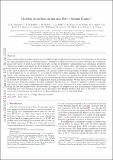| dc.contributor.author | Umurhan, O.M. | |
| dc.contributor.author | Howard, A.D. | |
| dc.contributor.author | Moore, J.M. | |
| dc.contributor.author | Earle, Alissa Michelle | |
| dc.contributor.author | White, O.L. | |
| dc.contributor.author | Schenk, P.M. | |
| dc.contributor.author | Binzel, Richard P | |
| dc.contributor.author | Stern, S.A. | |
| dc.contributor.author | Beyer, R.A. | |
| dc.contributor.author | Nimmo, F. | |
| dc.contributor.author | McKinnon, W.B. | |
| dc.contributor.author | Ennico, K. | |
| dc.contributor.author | Olkin, C.B. | |
| dc.contributor.author | Weaver, H.A. | |
| dc.contributor.author | Young, L.A. | |
| dc.date.accessioned | 2020-09-17T20:42:49Z | |
| dc.date.available | 2020-09-17T20:42:49Z | |
| dc.date.issued | 2017-05 | |
| dc.date.submitted | 2016-12 | |
| dc.identifier.issn | 0019-1035 | |
| dc.identifier.uri | https://hdl.handle.net/1721.1/127647 | |
| dc.description.abstract | Observations of Pluto's surface made by the New Horizons spacecraft indicate present-day N2 ice glaciation in and around the basin informally known as Sputnik Planitia. Motivated by these observations, we have developed an evolutionary glacial flow model of solid N2 ice that takes into account its published thermophysical and rheological properties. This model assumes that glacial ice flows laminarly and has a low aspect ratio which permits a vertically integrated mathematical formulation. We assess the conditions for the validity of laminar N2 ice motion by revisiting the problem of the onset of solid-state buoyant convection of N2 ice for a variety of bottom thermal boundary conditions. Subject to uncertainties in N2 ice rheology, N2 ice layers are estimated to flow laminarly for thicknesses less than 400–1000 m. The resulting mass-flux formulation for when the N2 ice flows as a laminar dry glacier is characterized by an Arrhenius–Glen functional form. The flow model developed is used here to qualitatively answer some questions motivated by features we interpret to be a result of glacial flow found on Sputnik Planitia. We find that the wavy transverse dark features found along the northern shoreline of Sputnik Planitia may be a transitory imprint of shallow topography just beneath the ice surface suggesting the possibility that a major shoreward flow event happened relatively recently, within the last few hundred years. Model results also support the interpretation that the prominent darkened features resembling flow lobes observed along the eastern shoreline of the Sputnik Planitia basin may be the result of a basally wet N2 glacier flowing into the basin from the pitted highlands of eastern Tombaugh Regio. | en_US |
| dc.language.iso | en | |
| dc.publisher | Elsevier BV | en_US |
| dc.relation.isversionof | http://dx.doi.org/10.1016/j.icarus.2017.01.017 | en_US |
| dc.rights | Creative Commons Attribution-NonCommercial-NoDerivs License | en_US |
| dc.rights.uri | http://creativecommons.org/licenses/by-nc-nd/4.0/ | en_US |
| dc.source | arXiv | en_US |
| dc.title | Modeling glacial flow on and onto Pluto’s Sputnik Planitia | en_US |
| dc.type | Article | en_US |
| dc.identifier.citation | Umurhan, O.M. et al. "Modeling glacial flow on and onto Pluto’s Sputnik Planitia." Icarus 287 (May 2017): 301-319 © 2017 Elsevier Inc | en_US |
| dc.contributor.department | Massachusetts Institute of Technology. Department of Earth, Atmospheric, and Planetary Sciences | en_US |
| dc.contributor.department | Massachusetts Institute of Technology. Department of Aeronautics and Astronautics | en_US |
| dc.relation.journal | Icarus | en_US |
| dc.eprint.version | Original manuscript | en_US |
| dc.type.uri | http://purl.org/eprint/type/JournalArticle | en_US |
| eprint.status | http://purl.org/eprint/status/NonPeerReviewed | en_US |
| dc.date.updated | 2019-09-26T12:56:26Z | |
| dspace.date.submission | 2019-09-26T12:56:36Z | |
| mit.journal.volume | 287 | en_US |
| mit.metadata.status | Complete | |
